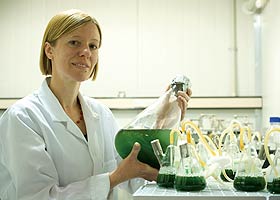
 Dr Tina Summerfield:
Dr Tina Summerfield:
“We want to understand the conditions under which they [cyanobacteria] produce hydrogen to see if we can stimulate them to produce more.”
We might be surrounded by plentiful alternative sources of fuel and not even know it.
Cyanobacteria are simple organisms found in almost all environments on earth. They use photosynthesis to capture energy from sunlight and produce hydrogen and small amounts of ethanol, which makes them a potential source of renewable energy for fuel cells.
But not all cyanobacteria are equal. Dr Tina Summerfield (Department of Botany) is trying to find strains that might lead to developing organic hydrogen factories as an alternative to fossil fuels.
She is currently investigating three “model” strains – ones that have been studied intensively so their characteristics are well known – and about a hundred new strains isolated in New Zealand by Dr Susie Wood, at Nelson's Cawthron Institute.
Summerfield is testing the model strains in different environments to maximise hydrogen production.
“We want to understand the conditions under which they produce hydrogen to see if we can stimulate them to produce more,” she says. The new cyanobacterial strains are more of a mystery as their hydrogen production is untested.
The Cawthron Institute has also been studying their toxin production. “One of the negative things about cyanobacteria is that they can produce blooms and toxins, which are often found in freshwater environments – algal blooms are often not algae, but cyanobacteria,” says Summerfield.
“Cyanobacteria used to be called blue-green algae and were thought to be directly related to plants because of their photosynthetic properties.”
Now there is an international drive to study their hydrogen production.
“Hydrogen is an alternative fuel, so what we are doing is effectively part of a global initiative looking at different ways to capture light energy through photosynthesis to produce useful products.
“Testing the new strains is a bit like panning for gold. We don't know what we're going to see, so it's very exciting,” says Summerfield.
But don't get your hopes up too high for plentiful hydrogen power just yet. “The research is at a very early stage. If we find an ideal cyanobacteria strain that produces enough hydrogen to make it feasible to grow cultures there will still be a lot of downstream work on maintaining the right conditions. There's a great deal to be done before this becomes commercially viable.”
Funding
- Marsden Fund
- University of Otago
